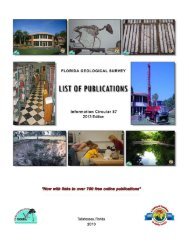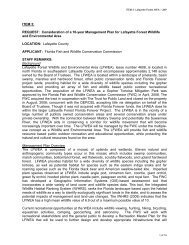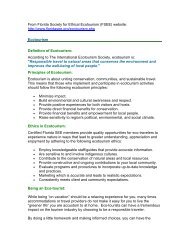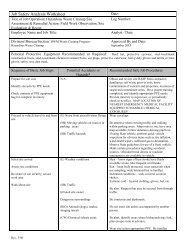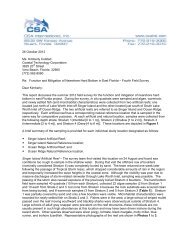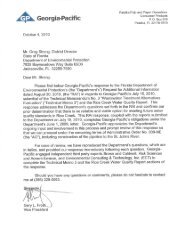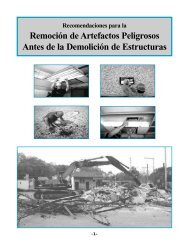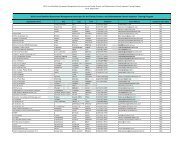A Framework for Coastal Water Resource Monitoring in Florida
A Framework for Coastal Water Resource Monitoring in Florida
A Framework for Coastal Water Resource Monitoring in Florida
Create successful ePaper yourself
Turn your PDF publications into a flip-book with our unique Google optimized e-Paper software.
B. Introduction and Overview<br />
<strong>Florida</strong> <strong>Coastal</strong> <strong>Monitor<strong>in</strong>g</strong> <strong>Framework</strong><br />
1) Statement of Intent<br />
Develop<strong>in</strong>g a framework <strong>for</strong> a comprehensive coastal water resources monitor<strong>in</strong>g<br />
network is a Secretarial Strategic Priority of the Department of Environmental Protection.<br />
This document has been drafted <strong>in</strong> response to this high priority call <strong>for</strong> greater protection<br />
of <strong>Florida</strong>’s coastal and mar<strong>in</strong>e environments.<br />
<strong>Florida</strong>’s coasts and ocean waters are the basis <strong>for</strong> a significant portion of the state’s<br />
economy. Documented decl<strong>in</strong>es <strong>in</strong> coastal water quality and reduction <strong>in</strong> available<br />
resources such as <strong>in</strong> the sport and commercial fishery prompt FDEP to establish<br />
expanded monitor<strong>in</strong>g along <strong>Florida</strong>’s entire coastl<strong>in</strong>e and adjacent waters. The goal is to<br />
<strong>in</strong>corporate exist<strong>in</strong>g monitor<strong>in</strong>g ef<strong>for</strong>ts, where appropriate, as part of <strong>for</strong>m<strong>in</strong>g a new and<br />
more comprehensive ef<strong>for</strong>t and to <strong>in</strong>tegrate the coastal monitor<strong>in</strong>g with <strong>Florida</strong>’s<br />
freshwater Integrated <strong>Water</strong> <strong>Resource</strong> <strong>Monitor<strong>in</strong>g</strong> network.<br />
This framework document will be followed with a more detailed monitor<strong>in</strong>g plan lay<strong>in</strong>g<br />
out implementation details and strategies <strong>for</strong> each part of the <strong>Monitor<strong>in</strong>g</strong> <strong>Framework</strong>.<br />
2) Process description<br />
FDEP assembled a Technical Advisory Group (TAG) <strong>for</strong>med of representatives from<br />
state and federal agencies, and academia to provide <strong>in</strong>put on creat<strong>in</strong>g a framework around<br />
which to build the coastal monitor<strong>in</strong>g network.<br />
The state’s monitor<strong>in</strong>g needs were assessed as a function of the state agencies’ previously<br />
established Management Needs. A master list of these needs was compiled by the<br />
<strong>Florida</strong> Oceans and <strong>Coastal</strong> Council as part of their ef<strong>for</strong>t to prioritize research needs<br />
around <strong>Florida</strong>’s coasts. From this master list was extracted a subset of the Management<br />
Needs of the state agencies with coastal resource management responsibilities and those<br />
NGOs (non-governmental organizations) that are <strong>in</strong>volved <strong>in</strong> similar ef<strong>for</strong>ts. The TAG<br />
also considered the needs of cooperative programs such as those the state currently has<br />
with the U.S. Environmental Protection Agency (EPA) and the National Oceanic and<br />
Atmospheric Adm<strong>in</strong>istration (NOAA).<br />
3) Goals<br />
One goal established <strong>for</strong> the monitor<strong>in</strong>g framework was to implement a monitor<strong>in</strong>g<br />
network that, at a m<strong>in</strong>imum, provided <strong>in</strong><strong>for</strong>mation about both status (the condition of the<br />
resource at the time of sampl<strong>in</strong>g) and trend (the change <strong>in</strong> status over time). The network<br />
will be based on the referenced Management Needs of the member agencies and will<br />
provide an annual “Report Card” of easily understood <strong>in</strong><strong>for</strong>mation about the status and<br />
trends of coastal water resources <strong>for</strong> each of the “Report<strong>in</strong>g Areas” that are identified.<br />
4) Types of <strong>Monitor<strong>in</strong>g</strong><br />
<strong>Monitor<strong>in</strong>g</strong> can provide <strong>in</strong><strong>for</strong>mation on physical-chemical factors (<strong>for</strong> <strong>in</strong>stance, sal<strong>in</strong>ity,<br />
temperature, contam<strong>in</strong>ant concentrations), habitat (<strong>for</strong> <strong>in</strong>stance, the size of seagrass beds,<br />
changes <strong>in</strong> coral reef coverage), and measurements that reveal the overall condition of the<br />
ecosystem (<strong>for</strong> <strong>in</strong>stance, <strong>in</strong><strong>for</strong>mation on the relative health of a biological community).<br />
2





